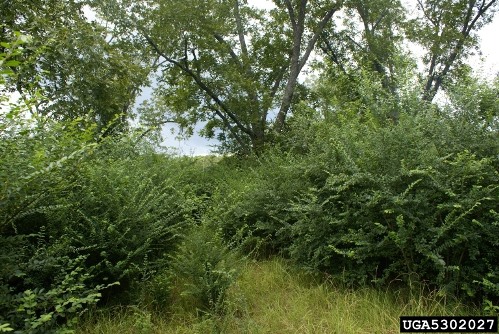
Plants to Avoid in Gardens
I have been an avid home gardener most of my life, starting as a toddler in my mom’s and dad’s garden in the 1940s. I love most plants, and of course especially the ones with beautiful flowers. But there are some plants I have learned to NOT tolerate in my garden. At least not if I can avoid, or eliminate, them. And the list includes several that are extremely popular/common around the country.
First on the list is Asian/Amur/Chinese privet (it has
several names), an introduced plant that has formed "privet deserts" in
thousands of places in America, many of them intended to be wildlife
refuges or city parks. Because this plant has no natural "enemies" in
this continent (having evolved thousands of miles away) it's virtually
indestructible and contributes little or nothing to our native
populations of insects, birds, and other animals except possibly an
occasional nesting spot for a bird. But the effort has to be made, and
armies of volunteers around the country spend many thousands of hours
fighting them. In my garden, however, the fight is on me and (mostly) my
gardener.
The Amur privet (Ligustrum amurense sp.) is an exotic (i.e.,
not native to these parts) shrub or subshrub that is originally from
northern China where it has been growing, both wild and domesticated,
for thousands of years (probably millions of years in the wild).

|
|
It is a dense, erect, multi-stemmed, fast-growing deciduous shrub
that is semi-evergreen in areas with mild winters. It can grow up to
12-15 feet tall but is more usually seen at heights of 1 to 6 feet. The
leaves are usually rather small, elliptic to oblong in shape, dull green
and smooth. Flowers are creamy white, in panicles about 2 inches long,
and have an aroma that many people (including me) find unpleasant.
The fruit is a green oval berry that turns black when ripe
and contains a single seed. It ripens in the autumn and is spread by
birds and other animals all over the place. (At least some animals have
found it edible, which is often not the case for introduced plants.)
Ecological Threat
This plant grows well in average, dry to medium, well-drained
soils in full sun to part shade. (It does not do well in wet
conditions.) It is tolerant of a wide range of soils and tolerant of
urban conditions. Plants will naturalize by self-seeding and often form
dense – even impenetrable -- thickets in areas where growth is not
controlled. Almost nothing else will grow in these thickets as the
privet is almost impossible for other plants to compete with. Hence the
“privet desert” description of these areas, which typically are
impossible to even walk through.
Over the long period since it was first introduced in North
America it has been planted extensively as a hedge or foundation shrub.
Birds can carry the berries for miles and plant them all over. To the
best of my information no native insects feed on them.
When I was a kid in Kansas in the 1940s virtually every front
yard on our block was bordered by privet hedges. And this was true of
thousands of similar neighborhoods all over the country. Our first real
house (rented) had a hedge like this in front that I "proudly" trimmed
into a very unnatural boxy shape. My current house came with about 40
feet of privet hedge at the back of the lot that has since spread all
over the place despite my best efforts to eradicate it. Privet was
originally introduced as a hardy replacement for boxwood. That was a
mistake we have been suffering for ever since. Privet is kind of like
the English sparrow/pigeon/starling of the plant world. Only worse, if
that’s possible.
My advice: NEVER PLANT THIS AND IF YOU HAVE SOME, ERADICATE
IT. Just cutting it down won’t kill it. The standard approach for
volunteer crews working to control large areas of privet is to cut it
flush with the ground, then paint the stumps with weed killer and cover
the painted stump with a weatherproof cup, as securely as possible. If
done right, this will eventually kill the remaining root system.
Difficult work, tedious, but usually effective. Learn to identify privet
on sight and work fast. Or it will literally “take the place”. In a
home garden just identifying, cutting to the ground, then repeating that
as needed, should give you fairly good control. About the only good
thing I can say about privet is that it isn’t actually poisonous. On the
other hand, thick stands of privet are an inviting spot for nesting
wasps to locate their nests. Twice in my life I’ve inadvertently backed
into a wasp nest in such a location. While I rather like wasps (at a
reasonable distance) I sure didn’t like that experience.
In future columns I intend to address such plants as Asian
honeysuckle, cherry laurel, vinca major, wild grape, snail seed,
greenbrier, chinaberry. Unlike privet, many of these plants are fine
species in their place, but their place is NOT in your home garden – not
unless you have endless acres and a rough-and-ready approach to
gardening.
©2022 John I. Blair 8/31/2022





No comments:
Post a Comment